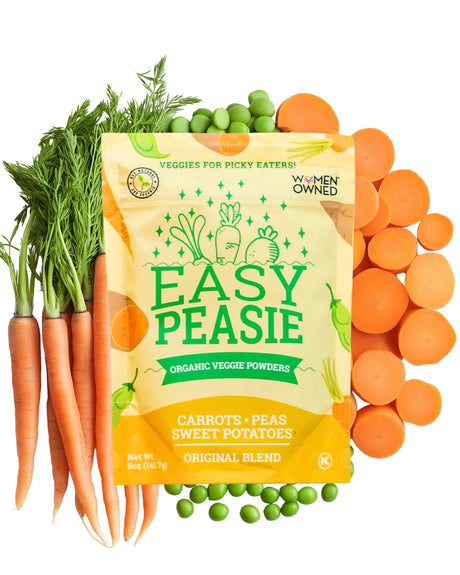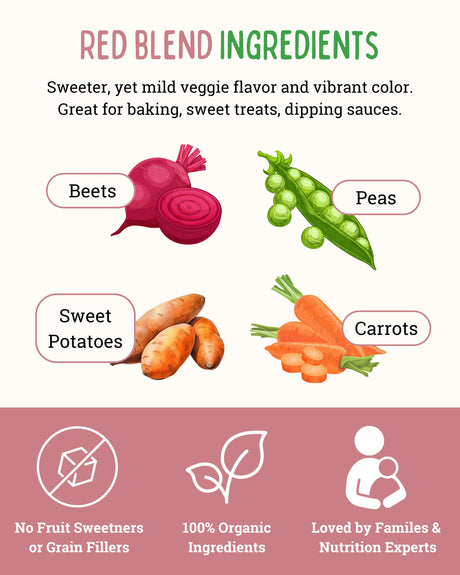Embracing the Texture Challenge
Welcome to the world of picky eaters, where every meal can feel like a new adventure or a daunting challenge. One of the less discussed, yet crucial aspects of picky eating, is the role of texture.
It's not just about flavors; how food feels can be just as important, especially for our little ones. In this journey, we're not just nourishing their bodies but also nurturing their sensory experiences.
The Significance of Texture
Why does texture matter so much? For children, the mouthfeel of food can be a make-or-break factor. Some kids might reject foods that are too crunchy, too slimy, or too lumpy without even considering the taste.
It's a sensory reaction, deeply rooted in their developmental stage and personal comfort zones. Understanding this can be a game-changer in how we approach meal times.
Our Mission: Texture Triumphs
Our goal here is simple yet profound. We aim to arm you, the parents, with creative, compassionate, and effective strategies to introduce new textures to your picky eaters.
It's about transforming mealtime from a battleground to a playground of tastes and textures. Let's embark on this flavorful journey with patience, understanding, and a sprinkle of culinary creativity!
The Role of Sensory Play in Food Exploration
Sensory Play: A Gateway to New Textures
Introducing new textures to children isn't just about what happens at the dining table. It's a broader sensory journey. Sensory play, an engaging and non-threatening approach, can be a powerful tool in helping kids become more comfortable with various textures. It's about taking the pressure off eating and turning it into a fun, exploratory experience.

Building Comfort Through Touch
Before a child can feel comfortable eating a new texture, they often need to feel comfortable simply touching it. Sensory play allows children to explore different textures with their hands, which can be a less intimidating first step. This tactile exploration lays the groundwork for oral acceptance. It's a transition from 'feeling' to 'tasting'.
Creative Sensory Activities with Food
Let's dive into some playful activities that can make this journey enjoyable. How about a 'texture treasure hunt' with cooked pasta? Spaghetti can be wiggly and squishy, while penne holds a firmer shape. Create a sensory bin filled with different types of cooked pasta and let your child explore with their hands.
Another fun activity is the 'fruit and veggie feel box'. Fill a box with a variety of fruits and vegetables with different textures. Let your child reach in and describe what they feel. Is it bumpy like a pineapple, smooth like a tomato, or rough like a kiwi? These activities are not just about touching; they're about describing, thinking, and eventually tasting.
The Joy of Messy Play
Don't shy away from a little mess. Sometimes, the best sensory play involves getting hands dirty (literally!). Smashing soft fruits, squishing tomatoes, or playing with rice can be delightful and educational. It's all about breaking down the barriers between your child and new textures, one playful touch at a time.
Gradual Introduction of New Textures
Embracing Patience in Texture Exploration
Introducing new textures to picky eaters is a journey that requires patience and persistence. It's not an overnight change but a gradual process. The key is to take small steps, ensuring that each new texture is introduced in a way that's comfortable and non-threatening for the child. Remember, every small victory counts in this journey.
The Step-by-Step Texture Ladder
Think of introducing new textures as climbing a ladder, one rung at a time. Start with textures that are only slightly different from what your child is already comfortable with.
For instance, if they like smooth applesauce, the next step could be mashed apples with a bit more texture. Gradually increase the texture complexity as they become more comfortable.
Combining the Old with the New
A great strategy is to mix familiar textures with new ones. This can make the new textures less intimidating.
If your child loves creamy yogurt, try adding some granola for a gentle introduction to a crunchier texture. The key is to start with small amounts of the new texture and gradually increase as your child becomes more accustomed to it.
Familiar Flavors, New Textures
Another effective approach is to maintain familiar flavors while changing the texture. For example, if your child enjoys the taste of bananas, try offering them in different forms - mashed, sliced, or even in a smoothie. This familiarity in taste can provide a comfort zone while they explore the new texture.

Consistency is Key
Consistency in offering new textures is crucial. Regular exposure, even if they don't try it every time, helps normalize these new experiences. Over time, the unfamiliar becomes familiar, and the once daunting texture becomes just another part of their meal.
Making Mealtime Fun and Engaging
Involving Kids in the Kitchen
One of the most effective ways to encourage children to try new textures is by involving them in meal preparation. This hands-on experience allows them to touch, feel, and become familiar with different food textures before they even reach the table.
For instance, let them help mash potatoes or mix salad ingredients. This involvement not only demystifies the food but also gives them a sense of ownership and pride in what they've helped create.
Creative Cooking Adventures
Turn meal preparation into a fun and creative adventure. Let your kids use cookie cutters to create shapes out of foods with different textures, like whole grain bread or thinly sliced firm fruits and vegetables. This playful approach can make new textures seem more approachable and less intimidating.
Artistic Food Plating
The way food is presented can significantly impact a child's willingness to try it. Arrange food in a visually appealing manner on the plate. You can create smiley faces with different textured foods or use colorful bowls and utensils. The goal is to make the meal look so fun and inviting that the new textures become secondary to the excitement of the meal.
Theme-Based Meals
Introduce theme-based meals where the focus is on the fun aspect rather than the food itself. For example, have a 'Green Day' where you incorporate green vegetables of various textures into the meals. Or, create a 'Beach Day' theme with foods that have textures reminiscent of the beach, like crunchy crackers (sand) and wobbly jello (water).
Storytelling with Food
Use storytelling to make mealtime more engaging. Create a story around the meal, where different textured foods play characters in the tale. For instance, crunchy carrots could be 'forest logs' and mashed potatoes could be 'clouds'. This imaginative play can make trying new textures a part of the story, adding an element of fun and curiosity.
Rewarding Exploration
Consider setting up a reward system for trying new textures. This doesn't have to be a physical reward; it could be as simple as a sticker or an extra story at bedtime. The idea is to make the exploration of new textures something that is acknowledged and celebrated, reinforcing positive experiences around food.
Recipes That Embrace Diverse Textures
Texture Adventure Dishes
Introducing a variety of textures in a single meal can be a delightful adventure for kids. Start with simple, kid-friendly recipes that naturally incorporate different textures.
For example, a crunchy and creamy salad combines the crispness of fresh vegetables with the smoothness of a yogurt-based dressing. Or, a fruit and nut oatmeal offers the softness of cooked oats with the added crunch of nuts and the juiciness of fresh fruits.

Customizable Stir-Fry
A stir-fry is a fantastic way to introduce a range of textures in a fun and customizable dish. Use a base of soft noodles or rice, add a variety of vegetables like bell peppers for crunch and mushrooms for a more meaty texture, and finish with a protein of your choice. Allow kids to choose which ingredients they want to include in their stir-fry, giving them control over the textures they're ready to explore.
Smooth and Crunchy Parfaits
Create parfaits with layers of yogurt (smooth), granola (crunchy), and soft fruits like berries or banana slices. This combination of textures can be very appealing to kids. The contrasting sensations in each bite make the eating experience fun and interesting. Plus, parfaits can be easily customized to include the textures your child prefers.
Dips and Dippers
Offer a variety of 'dippers' with different textures alongside a smooth dip. For example, serve hummus or a yogurt-based dip with an assortment of dippers like carrot sticks (crunchy), bell pepper strips (crisp), whole grain pita bread (soft), and cucumber rounds (juicy). This not only introduces a variety of textures but also encourages kids to experiment with different flavor combinations.
Build-Your-Own Tacos
Tacos are another excellent way to explore textures. Provide soft tortillas, a selection of fillings like ground meat or beans (soft), grated cheese (creamy), lettuce (crisp), and diced tomatoes (juicy). Letting children build their own tacos gives them the freedom to experiment with textures at their own pace.
Customization Tips
When introducing new textures, it's important to consider individual preferences. If your child is hesitant about a particular texture, try introducing it in small amounts.
For example, if they're unsure about crunchy vegetables, start by adding a small amount to a dish they already like. Gradually increase the quantity as they become more comfortable.
Remember, the key is patience and persistence – it's all about making the exploration of new textures a positive and stress-free experience.
The Importance of a Positive Mealtime Environment
Crafting a Stress-Free Mealtime Atmosphere
Creating a relaxed and enjoyable mealtime environment is crucial in encouraging children to try new textures. A stress-free setting allows kids to explore food at their own pace without feeling pressured. Keep mealtime conversations light and positive, and avoid focusing solely on what or how much your child is eating. This approach helps reduce any anxiety around meals and makes the experience more about discovery and enjoyment.
The Power of Family Meals
Family meals are more than just eating together; they're an opportunity to bond and create a supportive environment. When the whole family sits down to eat, it provides an opportunity for children to observe and learn from others. Seeing parents and siblings enjoying a variety of textures can pique a child's curiosity and encourage them to experiment.

Role Modeling: Leading by Example
Parents and older siblings play a significant role in shaping a child's eating habits and attitudes towards food. When children see their family members trying and enjoying foods with different textures, they are more likely to feel confident in trying them too. It's important for parents to demonstrate a positive attitude towards food, including experimenting with new textures themselves.
Encouraging Exploration
Use mealtime as an opportunity to talk about the different textures and flavors in your meal. Discussing the crunchy carrots or the creamy yogurt can help children become more mindful and aware of their eating experience. This kind of conversation can turn mealtime into an exploratory activity rather than a chore.
Consistency and Routine
Establishing a consistent mealtime routine can also contribute to a positive environment. When meals happen at roughly the same time and place each day, it provides a sense of security and predictability for children. This consistency helps reduce mealtime stress and sets a calm tone for trying new foods and textures.
Celebrating Small Victories
Acknowledge and celebrate when your child tries a new texture, even if they don't end up liking it. This positive reinforcement encourages them to keep exploring and experimenting with new foods. Remember, the goal is to create a positive relationship with food, and every small step is a victory in that journey.
Embracing the Journey with Picky Eaters
As we wrap up our exploration of strategies for introducing new textures to picky eaters, it's important to remember that each child's journey with food is unique. The techniques we've discussed, from sensory play to making mealtime fun, are designed to gently guide your child towards a more diverse and enjoyable eating experience. Patience, creativity, and a dash of persistence are your best allies in this journey.
A Community of Support
To all the parents navigating the sometimes choppy waters of picky eating, know that you are not alone. Many families face similar challenges, and there's a community of support out there. Remember, introducing new textures is not just about the food; it's about nurturing a healthy relationship with eating and exploring the world of flavors and sensations together.
Sharing is Caring
We would love to hear from you! Your experiences, triumphs, and even the not-so-successful attempts are valuable stories that can inspire and guide others. If you've tried any of the strategies we've discussed, or if you have your own tips and tricks for introducing new textures to picky eaters, please share them with us, #easypeasie. Your insights could be the encouragement another parent needs.
Keep Exploring and Enjoying
Finally, keep exploring and enjoying the world of food with your child. Each new texture and flavor is an opportunity to learn and grow, not just for your child, but for the whole family. Celebrate the small victories, learn from the setbacks, and keep moving forward with love, laughter, and a sense of adventure at your dining table.
Leave your comments below; we love to hear from you! And don't forget to follow EasyPeasie for more veggie info and convo on YouTube, Facebook, and Instagram! ~ThePeas













